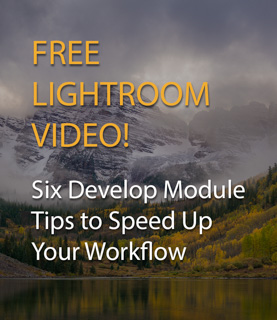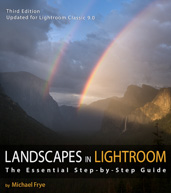In the Moment:
Michael Frye's Landscape Photography Blog
by Michael Frye | Feb 19, 2012 | Yosemite Photo Conditions
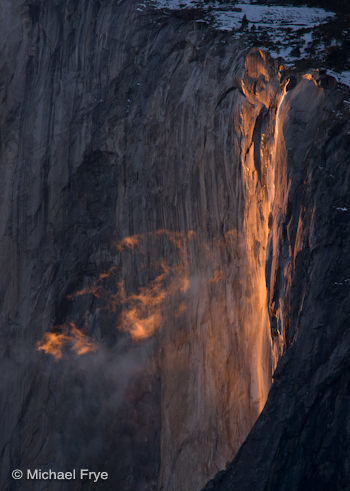
Horsetail Fall, 5:27 p.m., Wednesday, February 15th
First, a reminder that this is the last day to get a discount on my new eBook, Exposure for Outdoor Photography. Until midnight tonight you can use the code EXPOSURE4 at checkout to get the book for only 4 dollars. Or use the code EXPOSURE20 to get 20 percent off if you buy five or more Craft & Vision eBooks—including my previous volume, Light & Land: Landscapes in the Digital Darkroom.
Now, on to Horsetail Fall. Yosemite Valley received about four inches of snow on Tuesday night, and higher elevations got a little bit more. Unfortunately that precipitation did little to improve the water volume in Horsetail Fall. It’s flowing, but barely. Yet it’s amazing how little water it actually takes. You can strain your eyes to detect any flow at all for most of the day, and then as the sun lowers it highlights the fall perfectly and makes whatever water there is stand out.
The accompanying photographs were made on Wednesday and Thursday evenings while I was teaching private workshops, and show the current conditions pretty well. On Wednesday some mist drifted past the fall, adding interest, but distant clouds dimmed the light before it reached its most intense color. On Thursday, the light was about as good as it gets for Horsetail, lasting right until the theoretical sunset time, with the cliff behind the fall shaded. If only there was more water!
(more…)
by Michael Frye | Feb 16, 2012 | Announcements, Photography Tips
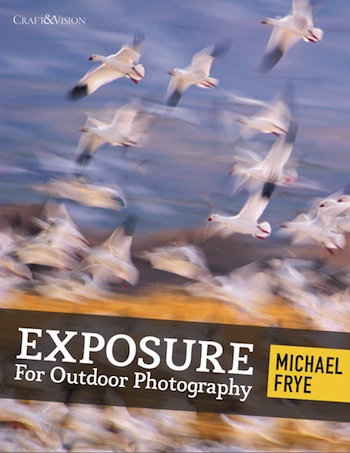
Exposure for Outdoor Photogoraphy
I’m pleased to announce the release of my second ebook: Exposure for Outdoor Photography.
In photography, creativity and technical skill are both essential. It’s great to have a wonderful eye and imagination, but no one will appreciate your genius if your images are washed out and blurry.
The most essential technical skill a photographer must master is exposure. On the surface, exposure seems easy. It’s simply a matter of making the image bright enough—not too dark, and not too light. But the endless variety of light makes exposure challenging. No two situations are the same, so there can be no exact formula for getting the right exposure. On the other hand, exposure doesn’t need to be overly complicated. The fundamental controls—shutter speed, aperture, ISO, light meters—are easy to understand.
Previously on this blog I’ve written about some of these fundamentals, like reading histograms and adjusting exposure. In this ebook I start with a more comprehensive discussion of these essentials, then go deeper by taking you through ten practical, real-life examples where I’ve used these basic principles to control the exposure, the sharpness, and the photograph’s message.
The examples go from easy to complex, and include using a histogram to find the right exposure, controlling depth of field, freezing and blurring motion, when to push the ISO, spot metering and the Zone System, and HDR and exposure blending. I also include several exercises to help improve your technique. It’s a concise, easy to understand, yet comprehensive course in mastering the most important skill in photography.
Like all Craft & Vision ebooks, Exposure for Outdoor Photography is normally only five dollars. But for the next four days you can get it for only four dollars. Just use the code EXPOSURE4 at checkout. Or use the code EXPOSURE20 to get 20 percent off if you buy five or more Craft & Vision ebooks—including my previous volume, Light & Land: Landscapes in the Digital Darkroom.
Exposure for Outdoor Photography is temporarily unavailable. Stay tuned for updates on a revised version.
—Michael Frye
Related Posts: Light & Land eBook Available Today!; Digital Photography Basics: Reading Histograms; Digital Photography Basics: Adjusting Exposure
Michael Frye is a professional photographer specializing in landscapes and nature. He is the author and photographer of The Photographer’s Guide to Yosemite, Yosemite Meditations, and Digital Landscape Photography: In the Footsteps of Ansel Adams and the Great Masters, plus the eBook Light & Land: Landscapes in the Digital Darkroom. He has written numerous magazine articles on the art and technique of photography, and his images have been published in over thirty countries around the world. Michael has lived either in or near Yosemite National Park since 1983, currently residing just outside the park in Mariposa, California.
by Michael Frye | Feb 13, 2012 | Wildlife Photography

1. Ross's geese taking flight in the fog
I’ve had a love affair and obsession with snow geese, along with their close cousins Ross’s geese, for 25 years. Watching a large flock of these birds take flight, filling the sky from horizon to horizon while deafening your ears with their calls, is an unforgettable, transcendent experience.
I’ve photographed these birds in every way imaginable over the years. You can see more images of them in my album of bird photographs on Google+, including some deliberate blurs, and a flash-blur. Last Wednesday and Thursday Claudia and I drove down to the San Joaquin Valley once again to photograph birds. This time I focused on capturing ethereal images of geese in the fog, and tried looking straight into the late-afternoon sun. I’ve included some notes on the accompanying photos a little further down.
(more…)
by Michael Frye | Feb 12, 2012 | Yosemite Photo Conditions
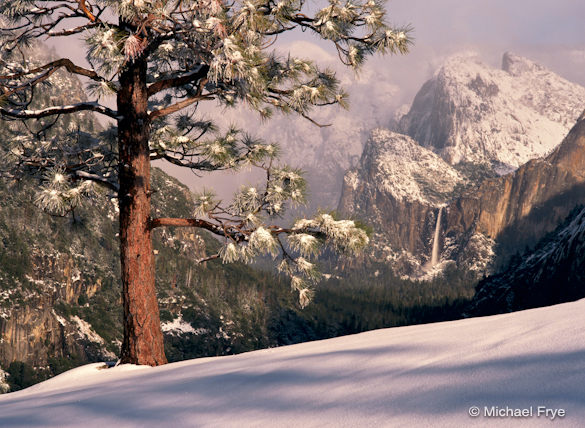
February light on Bridalveil Fall from near Turtleback Dome
First, I’m going to have a big announcement later this week—stay tuned!
Next, I’ve been getting lots of questions about Horsetail Fall. Since my last post about this not much has changed; there is little water in Horsetail right now. There’s snow in the forecast for tonight and tomorrow, so that should help, but they’re only predicting 6-8 inches, and I don’t know whether that will be enough to make a significant difference. If the weather warms immediately afterward and melts some of that new snow the water volume could get a bump, but it’s likely to be short-lived.
But there are other things to photograph in Yosemite in February. That storm is predicted to be a cold one, which means fresh snow in Yosemite Valley. And when the storm ends we could see some nice clearing storm conditions.
(more…)
by Michael Frye | Jan 26, 2012 | Yosemite Photo Conditions
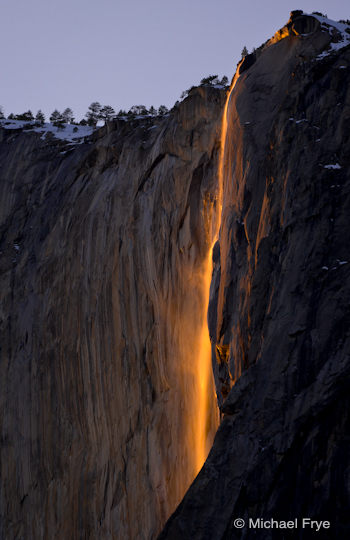
Horsetail Fall from "Rowell's View" near Northside Drive, February 19th, 2009, 5:29 p.m.
That special time of year is approaching, when children write letters to Santa Claus, people put colorful lights on the their houses and inflatable reindeer on their lawns, and… oh wait, wrong one. That other special time of year is approaching, when photographers of every stripe migrate to a sheltered valley in the Sierra Nevada, and Nikon and Canon users stand side by side in peace and harmony, hoping for a break in the clouds and a moment of magic. Yes, Horsetail Fall season is coming.
The forecast for the season is, well, iffy. After two months with no precipitation whatsoever, Horsetail Fall was completely dry. But last weekend two storms dumped over five inches of rain in Yosemite Valley, and that precipitation fell as snow up higher. Horsetail Fall is fed by snow melting from a small drainage on top of El Capitan, and there is now some snow there, finally. But that’s not enough—we need two or three more snow dumps between now and mid-February. Then we need a stretch of clear, warm weather at the right time to melt some of that snow, feed the waterfall, and allow the sun to cast it’s golden, late-day light on the water. Not too much to ask, is it?
So when is that right time? An excellent question, but a difficult one to answer. In January 2009 I put an article on my web site describing how I used one of the Yosemite web cams to determine the optimum time for photographing Horsetail Fall. This was the best method I could find since it’s difficult to get on-the-ground first-hand information in February (too many clouds!). I thought the best time was an eleven-day window from approximately February 12th to 22nd.
My observations last year, however, have led me to question that conclusion. I photographed Horsetail on February 11th, and again on the 15th, and I think even the 15th was too early.
(more…)
by Michael Frye | Jan 24, 2012 | Yosemite Photo Conditions
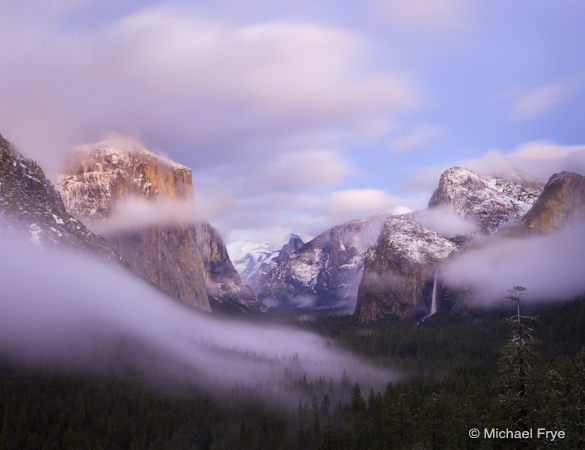
Clearing storm, dusk, Tunnel View, 5:30 p.m. Saturday
Those of you who live in California know that our two-month winter drought finally ended, with storms arriving on Friday and Sunday. Yosemite Valley received over five inches of rain total, and at higher elevations most of that precipitation fell as snow.
For photographers this meant that for the first time in months we had the opportunity to photograph clearing storms. Not only that, but both storms were considerate enough to time their clearing perfectly and break up just before sunset.
(more…)
by Michael Frye | Jan 12, 2012 | Photography Tips, Yosemite Photo Conditions
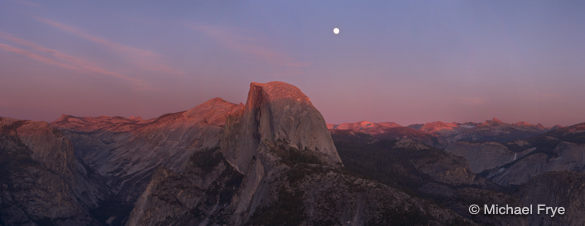
Moonrise from Glacier Point Saturday evening
In my post last Thursday I mentioned that there might be a good opportunity to photograph the moonrise from Glacier Point on Saturday evening. So Claudia and I went to Glacier Point that night, where we met lots of photographers. It was nice to see familiar faces, and meet some online acquaintances in person. Thanks to all of you who came up to me and said hello!
Of course in between socializing we all photographed the moon rising behind Half Dome. My favorite image from this evening is the panorama above (stitched together from five separate frames). If you were there, I’d love to see the images you made, so please post a link in the comments. And if you photographed the moon somewhere else, I’d like to see those images too!
(more…)
by Michael Frye | Jan 11, 2012 | Digital Darkroom
As many of you know, Adobe released a beta version of Lightroom 4 yesterday. There are some major changes to the Develop Module—the Brightness slider has disappeared, while the Recovery and Fill Light tools have been replaced by Highlights and Shadows. Adobe says these Highlight and Shadow tools were improved, and a quick test bears this out—I was able to recover detail in an overexposed moon with Lightroom 4 and not with Lightroom 3. There’s also a new Whites slider, the Blacks slider is quite different, you can adjust individual color channels with the Point Curve—and they’ve changed the default settings.
I’m looking forward to experimenting with the new tools, figuring out the new defaults, and sharing with you what I learn. In the mean time you can watch Julianne Kost give an overview of the new features, or describe the specific changes to the Develop Module. To download the beta, click here.
Remember that this his a beta, so it’s bound to have bugs, and the final shipping version will be different, so adjustments you make now might not translate to the finished version. If you want to import a few images into the beta version to try it out, great, but I don’t recommend that you start using Lightroom 4 beta as your primary tool until the final version ships.
You can’t upgrade your current catalog to Lightroom 4, which is good—you don’t want to mess with your existing catalog. Adobe also recommends that you don’t save metadata to XMP, and I wholeheartedly agree. Don’t Save—don’t press Command-S on a Mac, or Control-S on Windows, and make sure the option to automatically write changes into XMP is turned off. It’s turned off by default in Lightroom 4, but to check go to your Catalog Settings (under the Lightroom menu on Macs, or under the Edit menu on Windows), click on the Metadata tab at the top, and make sure that “Automatically write changes into XMP ” is unchecked. And while you’re at it uncheck “Include Develop settings in metadata inside JPEG, TIFF, and PSD files” also.
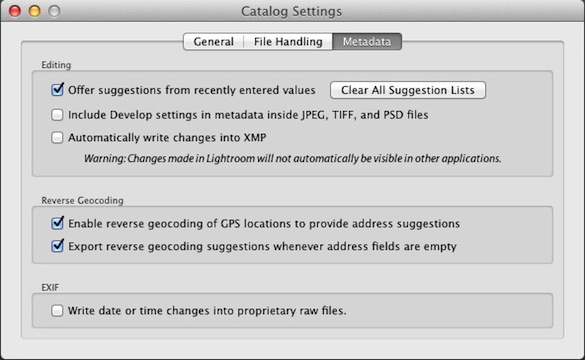
Now in Lightroom 3 I do recommend—highly—that you check these boxes. To understand why, and what all XMP stuff means, we have to talk about some fundamental aspects of how Lightroom works, so if you want to delve into these details read on.
Lightroom is a non-destructive editor, which means that when you make changes to a photograph’s appearance, Lightroom does not modify the original Raw or JPEG file, but rather writes a set of instructions about how you want to the image to look. Those instructions don’t get applied until and unless you export the image out of Lightroom (like when you take it into Photoshop, or export a JPEG to put on a web site).
Those instructions are automatically written into the Lightroom database, and can also be written into the image file itself with JPEG, TIFF, PSD, and DNG files, or with other Raw files (NEF, CR2, etc.) into a sidecar file with a .xmp extension. So with Lightroom 4 you want avoid writing writing those instructions into the image file, or a sidecar file, because those instructions won’t be compatible with Lightroom 3, and may not be compatible with the final version of Lightroom 4. But with Lightroom 3 you want to write those instructions (the metadata) into the file or sidecar file so that if Lightroom catalog ever gets corrupted those instructions, your edits to all your images, won’t be lost, because the information will be stored with the image itself. Also, that information can be read by other programs, namely Adobe Camera Raw and other copies of Lightroom.
So with that said, have fun playing with Lightroom 4, and I’ll be back with more after I’ve given it a thorough test drive.
by Michael Frye | Jan 6, 2012 | Announcements
The votes are in, and here are my top ten photographs for 2011 as chosen by you, the readers!
The response was truly extraordinary. 225 people looked through my initial selection of 41 images and posted their picks here on the blog, on Facebook, Google+, and by email. My deepest thanks to all of you who took the time to look through these photographs and voice your opinions. I really appreciate your help in making these difficult choices! And thanks to my most excellent assistant Claudia for tallying all those votes and running the print contest.
Did I say contest? Yes! We were so blown away by the response from all of you that we wanted to express our appreciation by giving away a print. We assigned a number to everyone who voted and used a random number generator to pick the recipient. And the winner is… (drumroll please) Earl Robicheaux! Earl will receive a signed, numbered, matted 16×20 print of his choice from among the 41 original selections. Congratulations Earl!
(more…)
by Michael Frye | Jan 5, 2012 | Yosemite Photo Conditions

Ice with reflections of cliffs at sunset, Yosemite, January 1st, 2012
It’s been a strange winter so far in Yosemite. Actually the word “strange” doesn’t do it justice—try weird, wacky, or even freakish. No measurable precipitation has fallen in Yosemite Valley since November 20th. There’s little snow in the high country, and the Tioga and Glacier Point roads are still open. The previous record for the latest closing date for Tioga Pass was January 1st, so with every snowless day that passes we’re setting a new record. And there’s no precipitation in the forecast for the next week.
But, as always, unusual conditions bring unusual opportunities. You can find interesting ice abstracts along Bridalveil Creek and the Merced River, like the one shown above that I made a few days ago while teaching a private workshop. And we have unprecedented access to the high country in January, and a chance to make some unusual moonrise images over the next few days. (more…)










